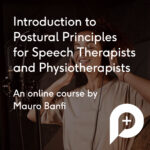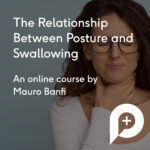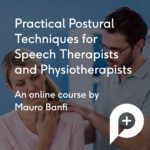Expand your interdisciplinary practice through a detailed understanding of posture and how it relates to speaking, gesturing and swallowing.
Everything you learn in this course will change your understanding of what is possible when physiotherapists and speech therapists work together. We developed this program specifically to improve MDT collaboration.
The knowledge and techniques gained through participation are immediately ready for use in any environment, everything can easily be transferred to sitting or standing positions. If you are wondering why this is so important, you have to attend to find out.
The tutor – Mauro Banfi
Mauro Banfi has been a physiotherapist since 1992 and an osteopath since 2000. Mauro works as a professional osteopath and physiotherapist in the field of sports, acrobatics and performing arts with a special interest in artistic voice problems in collaboration with speech therapists and ENT doctors and conservatoires.
For well over two decades he has been offering sessions and courses for performers, manual therapists, osteopaths and speech therapists in order to improve their manual skills in treating patient artists.

The program – posture principles for SLT & PT
Postural principles for SLT and the physio program
 This program aims to show the relationship between posture and other systems such as speaking and swallowing. Through a detailed discussion of the posture principles, you will learn about the most common causes of posture disorders. You will then be introduced to effective assessment and treatment strategies that will enable you to better manage patients with postural disorders.
This program aims to show the relationship between posture and other systems such as speaking and swallowing. Through a detailed discussion of the posture principles, you will learn about the most common causes of posture disorders. You will then be introduced to effective assessment and treatment strategies that will enable you to better manage patients with postural disorders.
Improve Your MDT Practice
The courses – three-course program
Postural principles for SLT and the physio program
 The relationship between posture and language is well known. Changes in posture have a direct impact on voice performance and patients with dysphonia often show specific posture disorders. If these postural abnormalities and associated muscular compensations are not addressed, singers can have persistent problems with their performance. This course therefore provides an in-depth discussion of posture and specific principles that can be used to treat postural disorders.
The relationship between posture and language is well known. Changes in posture have a direct impact on voice performance and patients with dysphonia often show specific posture disorders. If these postural abnormalities and associated muscular compensations are not addressed, singers can have persistent problems with their performance. This course therefore provides an in-depth discussion of posture and specific principles that can be used to treat postural disorders.
Understand the relationship between attitude and performance
The relationship between posture and swallowing
 Swallowing or swallowing is an essential physiological function that enables food to pass from the mouth to the stomach. Our ability to swallow changes with age and can be affected by a number of disorders, including neurological disorders such as stroke, multiple sclerosis, or ALS. Posture can also influence swallowing and can in turn be influenced by swallowing. Understanding the relationship between swallowing and posture is therefore essential in assessing patients with swallowing difficulties.
Swallowing or swallowing is an essential physiological function that enables food to pass from the mouth to the stomach. Our ability to swallow changes with age and can be affected by a number of disorders, including neurological disorders such as stroke, multiple sclerosis, or ALS. Posture can also influence swallowing and can in turn be influenced by swallowing. Understanding the relationship between swallowing and posture is therefore essential in assessing patients with swallowing difficulties.
Research the relationship between posture and swallowing
Practical posture techniques for speech therapists and physiotherapists
 There is a known relationship between posture and voice quality as well as posture and swallowing. When working with speech therapy patients, it is important to have the ability to assess the relationship between posture and these functions. This course introduces specific methods that can be used to assess and treat postural disorders. The techniques discussed in this course focus on standing and sitting postures that are easily adopted in speech therapy practice.
There is a known relationship between posture and voice quality as well as posture and swallowing. When working with speech therapy patients, it is important to have the ability to assess the relationship between posture and these functions. This course introduces specific methods that can be used to assess and treat postural disorders. The techniques discussed in this course focus on standing and sitting postures that are easily adopted in speech therapy practice.
Learn practical skills to improve your practice